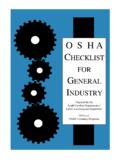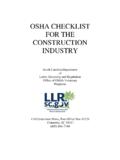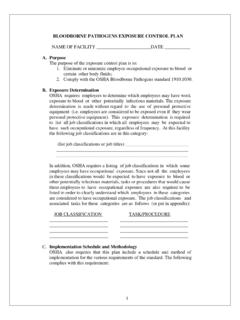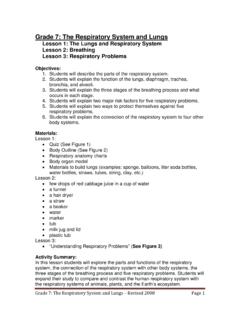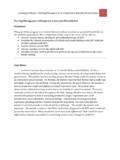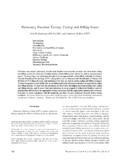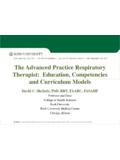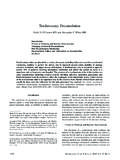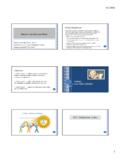Transcription of SAMPLE RESPIRATORY PROTECTION PROGRAM
1 1 SAMPLE RESPIRATORY PROTECTION PROGRAM I. Introduction In the control of those occupational diseases caused by breathing air contaminated with dusts, fogs, fumes, mists, gases, smokes, sprays or vapors, the primary objective shall be to prevent atmospheric contamination. This shall be accomplished as far as feasible by accepted engineering control measures (for example, enclosure or confinement of the operation, general and local ventilation, and substitution of less toxic materials). When effective engineering controls are not feasible, or while they are being instituted, appropriate respirators shall be used.
2 II. Purpose and scope The practices and procedures described here constitute the RESPIRATORY PROTECTION PROGRAM under which respirators are effectively utilized at (name of company) _____. III. Responsibility A. _____ (title or name of one person) is the respirator PROGRAM administrator. He/she is responsible for: 1. Administering the overall PROGRAM . 2. Implementing training and instruction programs . 3. Ensuring that medical evaluation procedures are implemented. 4. Selection and provision of appropriate respirators.
3 B. Supervisors are responsible for ensuring that the RESPIRATORY PROTECTION procedure is implemented in their particular of supervisors include: 1. Ensuring that employees under their supervision have received appropriate training, fit testing, and annual medical evaluations. 2. Ensuring the availability of appropriate respirators and accessories. 3. Being aware of tasks requiring the use of RESPIRATORY PROTECTION . 4. Enforcing the proper use of RESPIRATORY PROTECTION when necessary. 5. Ensuring that respirators are properly cleaned, maintained and stored according to the RESPIRATORY PROTECTION plan.
4 6. Ensuring that respirators fit well and do not cause discomfort. 7. Monitoring work areas and operations to identify RESPIRATORY hazards. C. Each employee has the responsibility to wear his or her respirator when and where required and in the manner in which they were trained and: 1. Care for and maintain their respirators as instructed, and store them in a clean sanitary location. 2. Inform the supervisor if the respirator no longer fits well, and request a new one. 3. Inform the supervisor or PROGRAM administrator of any RESPIRATORY hazards that they feel are not adequately addressed in the work place and of any other concerns that they have regarding the PROGRAM .
5 2 IV. Respirator Selection _____ ( PROGRAM administrator) will select respirators to be used on site, based on the hazards to which workers are exposed. He will conduct a hazard evaluation for each operation, process, or work area that will include: 1. Identification and development of a list of hazardous substances used in the workplace, by department, or work process. 2. Review of work processes to determine where potential exposures to these hazardous substances may occur. 3. Exposure monitoring to quantify potential hazardous exposures.
6 End of Service Life Indicators will be used. If there is no ESLI appropriate for conditions in the employer's workplace, the employer implements a change schedule for canisters and cartridges that is based on objective information or data that will ensure that canisters and cartridges are changed before the end of their service life. The employer shall describe in the respirator PROGRAM the information and data relied upon and the basis for the canister and cartridge change schedule and the basis for reliance on the data. EXPOSURE DEPARTMENT CONTAMINANTS LEVEL PEL CONTROLS (8-hr TWA) _____ _____ _____ ____ _____ _____ _____ _____ ____ _____ _____ _____ _____ ____ _____ _____ _____ _____ ____ _____ _____ _____ _____ ____ _____ _____ _____ _____ ____ _____ V.
7 Medical Evaluations 1. _____ ( PROGRAM administrator) is responsible for seeing that medical evaluations are conducted to determine that employees who are required to, or those who are allowed to voluntarily wear respirators are medically able to do so. 2. _____ ( name of licensed health care professional) of _____ (name of clinic or hospital) will provide the medical evaluations. 3. Medical evaluations will be conducted using Appendix C of the standard. _____ ( PROGRAM administrator) will give a copy to all employees requiring medical evaluations to complete and _____ _____ (how to send or take to doctor or clinic/hospital).
8 4. Follow-up medical exams will be granted as found necessary by the _____ (doctor or clinic/hospital). 5. All employees will be granted an opportunity to speak with _____ 3(doctor/licensed health care professional) about their medical evaluation, if they request to do so. 6. _____( PROGRAM administrator) will provide _____ (name of doctor or clinic/hospital) with a copy of this PROGRAM , a copy of the OSHA respirator standard, a list of hazardous substances in the work place, the employee s job title, proposed respirator type and weight, length of time required to wear respirator, expected physical work load, potential temperature and humidity extremes and protective clothing required.
9 7. After an employee has received clearance and begun to wear a respirator, additional medical evaluations will be provided when: a. the employee reports signs/symptoms related to their ability to use a respirator, such as shortness of breath, dizziness, chest pains, or wheezing. b. _____ (doctor or clinic/hospital) or supervisor informs the PROGRAM administrator that the employee needs to be re- evaluated. c. information from this PROGRAM , including observations made during fit tests and PROGRAM evaluation indicates a need for re-evaluation. d. a change occurs in workplace conditions that may impose an additional physiological burden on the employee.
10 PERSONNEL INCLUDED IN MEDICAL SURVEILLANCE PROGRAM WORK PROCEDURE/ TYPE NAME DEPARTMENT JOB DESCRIPTION RESPIRATOR _____ _____ _____ _____ _____ _____ _____ _____ _____ _____ _____ _____ _____ _____ _____ _____ _____ _____ _____ _____ VI. Fit Tests 1. _____ ( PROGRAM administrator) is responsible for conducting fit tests for all employees required to wear tight-fitting respirators.
